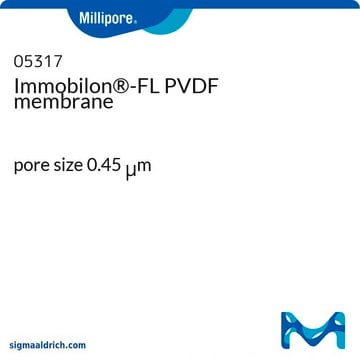IPFL00010
Immobilon® -FL PVDF Membrane
1 roll, 27 cm x 3.75 m, 0.45 µm pore size, transfer membrane with low background fluorescence
Sinónimos:
Western blotting membrane, blotting membrane, transfer membrane
About This Item
Productos recomendados
product name
Membrana de PVDF Immobilon®-FL, 1 roll, 27 cm x 3.75 m, 0.45 µm pore size, Hydrophobic PVDF Transfer Membrane with low background fluorescence for Western blotting. Compatible with visible and infrared fluorescent probes.
material
PVDF membrane
plain filter
white filter
Quality Level
feature
hydrophobic
manufacturer/tradename
Immobilon®
technique(s)
dot blot: suitable
western blot: suitable
filter L × W
27 cm × 3.75 m
pore size
0.45 μm pore size
capacity
155 μg/cm2 adsorption capacity (insulin)
205 μg/cm2 adsorption capacity (BSA)
300 μg/cm2 adsorption capacity (goat IgG)
compatibility
for use with All fluorescence dyes
for use with Amido black
for use with CPTS
for use with Coomassie brilliant blue
for use with Ponceau-S red
for use with Sypro<TMSYMBOL></TMSYMBOL> ruby
detection method
chemiluminescent
colorimetric
fluorometric
shipped in
ambient
Categorías relacionadas
General description
Application
Features and Benefits
- La primera membrana de transferencia optimizada para aplicaciones de fluorescencia; un fondo extremadamente bajo mejora la sensibilidad de todos los protocolos de detección de fluorescencia
- Compatible con todas las sondas fluorescentes utilizadas habitualmente en una amplia gama de longitudes de onda de excitación/emisión
- Mejor para detecciones de multiplexado y quimiofluorescencia
- Compatible con los bloqueantes y amortiguadores convencionales
Legal Information
Storage Class
11 - Combustible Solids
wgk_germany
WGK 3
flash_point_f
Not applicable
flash_point_c
Not applicable
Certificados de análisis (COA)
Busque Certificados de análisis (COA) introduciendo el número de lote del producto. Los números de lote se encuentran en la etiqueta del producto después de las palabras «Lot» o «Batch»
¿Ya tiene este producto?
Encuentre la documentación para los productos que ha comprado recientemente en la Biblioteca de documentos.
Los clientes también vieron
Protocolos
This page shows and discusses three protocols for stripping and reprobing a western blot membrane.
Protocol for sample preparation for cell lysis and efficient protein extraction from cultured tissues and cells for subsequent Western blotting.
Nuestro equipo de científicos tiene experiencia en todas las áreas de investigación: Ciencias de la vida, Ciencia de los materiales, Síntesis química, Cromatografía, Analítica y muchas otras.
Póngase en contacto con el Servicio técnico










